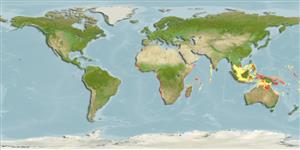Common names from other countries
>
Eupercaria/misc (Various families in series Eupercaria) >
Sciaenidae (Drums or croakers)
Etymology: Atractoscion: Greek, atraktos, arrow + Greek, skion, skiaina = barbel, red mullet (Ref. 45335).
More on author: Cuvier.
Environment: milieu / climate zone / depth range / distribution range
Ecologia
marinhas bentopelágico; intervalo de profundidade 15 - 200 m (Ref. 3593), usually 100 - 200 m (Ref. 3593). Tropical; 14°N - 28°S
Western Indian Ocean: off Mozambique and South Africa.
Comprimento de primeira maturação / Tamanho / Peso / Idade
Maturity: Lm ?, range 65 - ? cm
Max length : 130 cm TL macho/indeterminado; (Ref. 4373); common length : 90.0 cm SL macho/indeterminado; (Ref. 9772); peso máx. publicado: 25.0 kg (Ref. 4373)
Descrição suscinta
Chaves de identificação | Morfologia | Morfometria
Espinhos dorsais (total) : 10 - 11; Raios dorsais (total) : 25 - 32; Espinhos anais: 2; Raios anais : 9 - 10. Body silvery (Ref. 4373).
Found in coastal waters, over sand muddy bottom. Juveniles enter estuaries. Adults feed on pelagic fishes at night. Often caught with Umbrina canariensis. Feeds on pelagic fish such as mackerel and horse mackerel (Ref. 36731). Marketed fresh, flesh highly esteemed (Ref. 9772).
Ciclo de vida ou comportamento de acasalamento
Maturities | Reprodução | Spawnings | Egg(s) | Fecundities | Larvas
Chao, L.N. and E. Trewavas, 1990. Sciaenidae. p. 813-826. In J.C. Quero, J.C. Hureau, C. Karrer, A. Post and L. Saldanha (eds.) Check-list of the fishes the eastern tropical Atlantic (CLOFETA). JNICT, Lisbon; SEI, Paris; and UNESCO, Paris. Vol. 2. (Ref. 3593)
Status na Lista Vermelha da UICN (Ref. 130435)
CITES (Ref. 128078)
Not Evaluated
Ameaça para os humanos
Harmless
Uso pelos humanos
Pescarias: espécies comerciais; peixe esportivo: sim
Ferramentas
Relatórios especiais
Baixar XML
Fontes da internet
Estimates based on models
Preferred temperature (Ref.
115969): 14 - 26.5, mean 18.7 (based on 131 cells).
Índice de diversidade filogenética (Ref.
82804): PD
50 = 0.5312 [Uniqueness, from 0.5 = low to 2.0 = high].
Bayesian length-weight: a=0.00851 (0.00413 - 0.01752), b=3.08 (2.91 - 3.25), in cm Total Length, based on LWR estimates for this (Sub)family-body shape (Ref.
93245).
Nível Trófico (Ref.
69278): 4.5 ±0.80 se; based on food items.
Resiliência (Ref.
120179): Baixo, tempo mínimo de duplicação da população 4,5 - 14 anos (K=0.27; tm=5).
Fishing Vulnerability (Ref.
59153): Moderate to high vulnerability (51 of 100).
Climate Vulnerability (Ref.
125649): Very high vulnerability (83 of 100).
